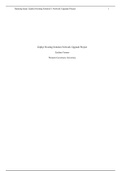Lecture notes
Defamation
This set of notes covers the topic of defamation in tort law. It contains lecture notes, case summaries, extracts from various textbooks, helpful pointers for answering exam questions, and useful material for essay questions specifically (academic articles/ opinions). Please note that this document...
[Show more]













